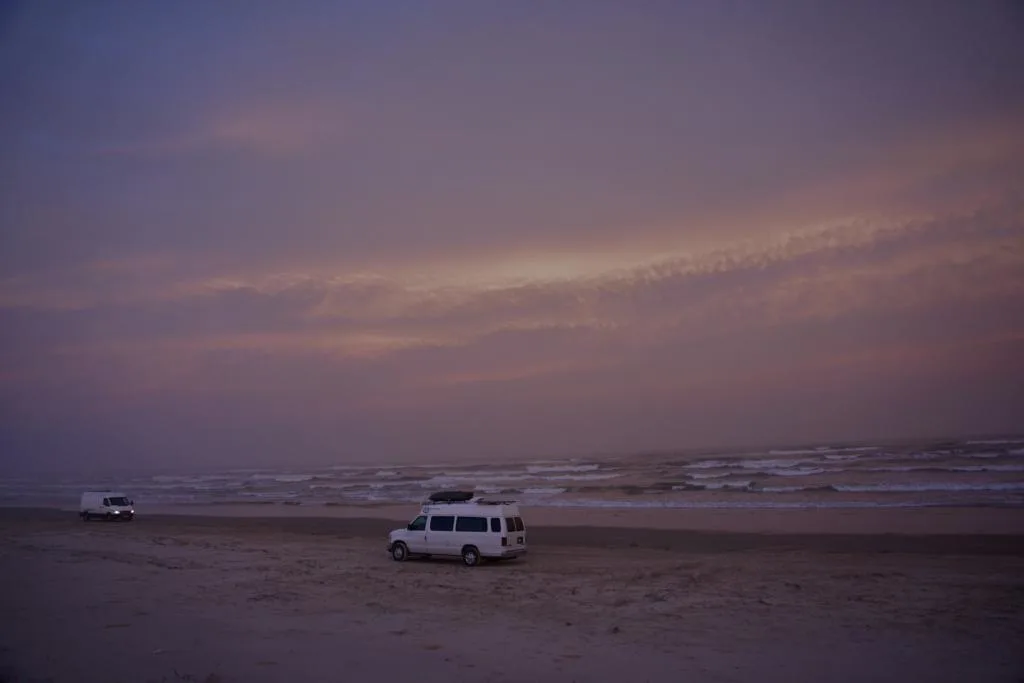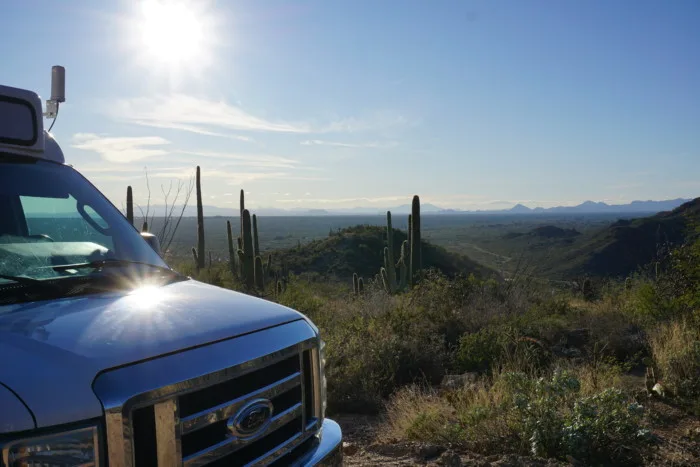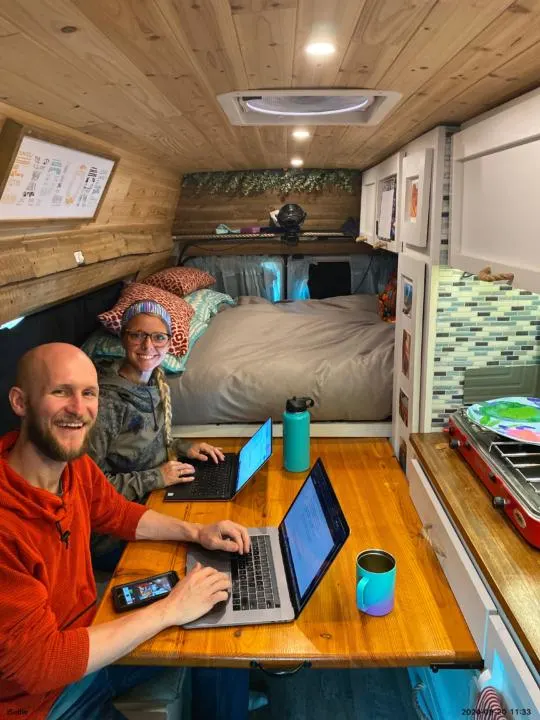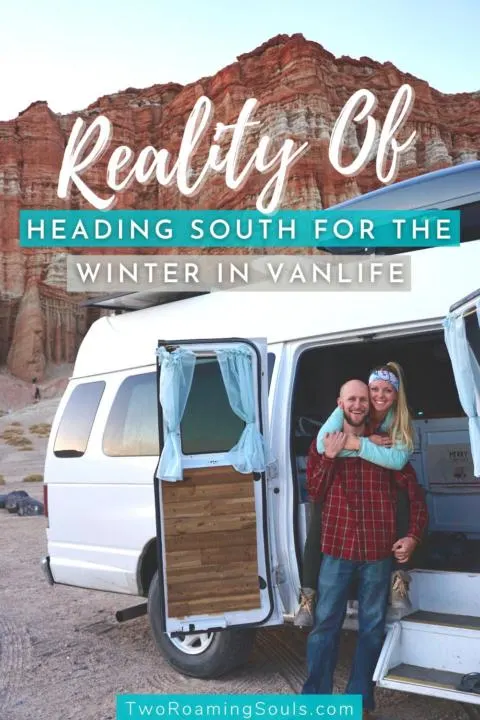
For many vanlifers and RVers, heading south is the best way to stay warm in the winter. “Snowbirds”, as they’re called, make up a decent percentage of the nomadic community. Emily and I have been snowbirds for the last two years in the US, and can share the true reality of heading south for the winter in Vanlife.
We want to share advice from what we’ve learned about living nomadically as snowbirds. Is lounging on the beach in January a viable lifestyle or some over-sold fairy tale.
The best way to think about the experience of vanlife is to consider the important factors.
Where can you park/camp at night, what kind of work/jobs exist, is there cell phone service, where can you buy food/etc, are there showers/laundry/bathrooms, what can you do for fun? The answers to those questions will largely impact the overall experience of vanlife in any place., but especially heading south for the winter in vanlife.
But it’s not one-size-fits-all, because even within the nomadic community, people have different needs and lifestyles. And so I’ll try to be clear about our specific biases.
We much prefer a boondocking lifestyle much more than stealth camping. So practically, that usually relegates us to less crowded areas. We like remote areas for the nature, solitude, and beautiful scenery. But that usually means less access to the perks of civilization like cell service, stores, etc.
Our experience is that while the snowbird lifestyle works well for many nomads, there’s a surprisingly small number of places that ‘check all the boxes’ for us.
Here’s why.
Not As Warm As It Seems
The first issue with traveling south in the winter to stay warm, is that it’s not as warm as it might seem. Sure you can find plenty of warm days in the winter, but there are often many cold nights too. And if you are living vanlife without a heater, you will experience the full force of those cold nights.
It gets old waking up to your van being 40 degrees (F) in the morning.
You may think that any of the southern states are sunny and warm all winter. But there’s really only a handful of locations in the US that stay warm year-round. And of course, you can go south of the border into Mexico and beyond, but I’ll touch on that later. Florida, Southern Texas, Southern Arizona, and Southern California are really the only spots that don’t get freezing cold at night.
Because it’s not just about latitude, the altitude also plays a large factor in the temperature.
Arizona and New Mexico

So take Arizona and New Mexico for example. People think of those states as really hot or warm practically all year-round. But because of the higher elevations, Northern Arizona and most of New Mexico get cold at night in the winter. It’s really only southwestern Arizona has low elevation and comfortable temperatures all winter.
Southern Arizona is especially friendly to long-term nomads. There’s plenty of boondocking and dispersed camping options. And cell service is also pretty good, even in remote areas.
But our main complaint about Southern Arizona is the rather boring desert landscape. Don’t get me wrong there are some cool things to see and do. But the sand, desert, and cactuses get old after a few months.
Southern California
Southern California has warm weather year-round. The low elevation and proximity to the ocean helps regulate the temperature. The problem with Southern California is that it’s very crowded and expensive along the coast, and then turns to a rather remote desert quickly as you drive inland.
So if you wish to be near the ocean, then your only option for parking at night is street parking or campgrounds/RV parks. If you prefer more of a boondocking lifestyle, then you will have to move away from the crowded coast.
Southeastern Cali has some interesting places to go, like Joshua Tree, Anza Boreggo State Park, and Death Valley National Park. But between the few unique places, there’s miles and miles of rather uninteresting desert.
Being near the ocean in Southern California is great! We love the warm weather and laid-back cities and towns. But my god is it crowded. And vehicle dwelling is a bit challenging in our experience. Unless you are paying for a place to park (like a campground/RV park), then it’s a constant grind finding street parking, worrying about theft, and trying not to overstay your welcome in any one spot. There are so many homeless and vehicles dwellers in SoCal that there’s already a strong stigma against the vanlife community.
Emily and I don’t really like street parking in our campervan in the winter. The main reason is that the sun goes down at like 4pm. And many public places close at sundown, so you really have no choice but to relocate to your “stealth” parking spot for the night. But it may be many hours before you go to bed, so things like cooking dinner or watching tv may attract negative attention. We don’t like the feeling that we need to “hide” every night in our van.
Southern Texas
Southern Texas is warm in the winter, for pretty much the same reasons as southern Cali (low elevation, proximity to ocean). The gulf water is also warmer than the Pacific Ocean, but not necessarily more inviting because it’s murky.
But one notable thing about Texas is that there’s basically no free dispersed camping in the entire state. So be prepared to fork some money for campgrounds/RV parks. Or find a job that provides a place to park.
Pretty much the only place that allows free camping in Texas is Padre Island National Seashore, which allows 14 days consecutive. It’s pretty cool because you can drive right on the beach and camp just feet away from the ocean. However, if you are picturing lounging on the beach in January, the main issue with Texas beaches is WIND. It is very windy in Texas, and it makes hanging out on the beach less fun. Sand is blowing frequently, the ocean is whitecapped, and your van is often rocking while you try to sleep.
So while the temperature might be just warm enough for beaching, the wind often ruins it. And if you’re vehicle is 2WD, then you need to be very cautious driving on beaches because it’s easy to get stuck. {Read about our essential campervan recovery gear}
The farther north you go in Texas the higher the elevation gets, and the colder you will be. West Texas is mostly boring desert, with a few exceptions: Big Bend National Park and Guadalupe Mountains National Park. But the higher elevations around those parks makes them a little cold for vehicle dwelling.
Florida
Florida is definitely the warmest US state to be in the winter. But the humidity can definitely be negative for vehicle dwelling. Though, it’s typically not as bad in the winter.
There hundreds of miles of coastline and definitely some decent beach weather if that’s what you are looking for.
Florida doesn’t have much in the way of boondocking. So either find a job that provides a place to park, pay for campgrounds, or prepare to cycle between urban street parking, boat launches, or bouncing between Wal-marts, truck stops, etc. Those latter options are usually fine for road-tripping if you’re on the move. But if you are doing it for an extended period of time it gets old.
South Of The Border
But if you are in search of even warmer weather in the winter, then you likely need to venture south of the border into Mexico (or perhaps further). This is a viable option that many nomads do each year. But it definitely brings it’s own challenges.
You may need to give extra consideration to visas, cell service/Wifi, healthcare, safety, language barriers, and more.
Emily and I have really wanted to travel into Mexico one winter, but have yet to make it happen. Luckily there are plenty of nomads and ex-pats willing to share advice on traveling in different parts of Mexico. Baja is known for being pretty safe, and a good starting point for Mexico newbs.
Finding Jobs / Working Remotely
If you plan to find a stationary job when heading south for the winter in vanlife, then the availability of jobs will be a crucial factor. However, if you are someone who works remotely then stable internet will be your biggest concern.
Seasonal Work
Emily and I have done lots of seasonal work over the last 5 years. Before vanlife we were living in ski town and doing mostly restaurant, hospitality, and service jobs. That’s how we came up with the idea to convert a campervan and alternate travel with seasonal jobs. We love seasonal work because it’s decent money, easy to learn, and you get free time in between jobs to travel and create this blog!
But seasonal work typically relies heavily on tourism, recreation, or agriculture. And while the winter might be warmer in the southern states, that doesn’t mean it’s the right time for seasonal work. This is probably our primary challenge of heading south for the winter in vanlife.
Besides ski resorts, there really aren’t that many true seasonal jobs in the winter. For example, one winter we lived in Sedona Arizona, but the tourism is at it’s lowest in the winter. So finding jobs wasn’t as easy because not many places were hiring for the slow season.
Plus, living in a vehicle in a ski town is becoming increasingly difficult because there’s nowhere to park or camp overnight.
And even in tourist areas, not all jobs in consider themselves seasonal. The manager may be expecting that you want the job year-round. So when you tell them that you plan on quitting in the spring, they might pass on you. A true seasonal job hires employees with the expectation that they will leave after the season. So finding the right job, right place, right time, is the major key to successful seasonal work.
We like to use websites like Coolworks.com or Vagajobs.com to find seasonal jobs. But if you filter out all ski town jobs, you aren’t left with much winter seasonal work.
Working Remotely

The major challenge for people working remotely is maintaining a reliable internet connection on the road. The most popular methods are using cellular data through a cell phone or hotspot, or going places with wifi, like coffee shops, libraries, etc. And both methods come with their own challenges depending on your work.
If your job requires you to be working at specific times on a daily basis, then it’s imperative that you build your life around that schedule. But if you work more fluid hours, then it gives you much more flexibility to work when and where you can.
For some remote work, speed and bandwidth will be critical for video conferencing or data-hungry tasks. And many places advertise free wifi, but you will quickly learn that not all Wifi is created equal. We typically prefer libraries because they usually have good wifi with no obligation to buy anything, but their hours are much more limited.
We have found that working at cafes, restaurants, etc is not the most productive way to work remotely. For starters, you need to “commute” to these places. Then you need to buy something, find a place to sit, move to a seat with an outlet when your computer runs out of battery, try to ignore the screaming baby, relocate when the business closes for the day, and the list goes on.
With the revolving door of challenges, we find there is plenty of lost time and productivity when working this way. It’s fine for getting a couple hours of work done here and there, but for full-time remote working, it’s really not an ideal option. And if you seek more remote areas when heading south for the winter in vanlife, then you may not even be able to find many businesses with good wifi.
The other good method is working remotely with cellular data or a mobile hotspot as a wifi network. This method is much better for productivity because you don’t need to leave your vehicle and you are in complete control of your “office”. However, it’s entirely dependant on being able to get good cell signal. And many remote areas that you may be camping won’t have good cell signal. We highly recommend getting a cell signal booster if you plan to work this way.
The other challenge you may encounter is limited solar power in the winter. If you get your power for your electronics from the sun, then the short days and low-angle sun can cause a problem. A solar kit that is adequate most of the year may struggle to produce enough electricity in the winter for your electronics and other needs.
We designed a tilt-mount for our solar panel to address this specific problem, and it truly makes a huge difference.
Conclusion | South For The Winter In Vanlife
Heading south for the winter in Vanlife is definitely a popular way to stay warm. But it’s not all sunshine and rainbows.
If you are in high elevation areas, you are likely to experience cold nights. Finding seasonal work is more difficult. The most desirable areas (usually by the ocean) are heavily populated and not especially vanlife friendly.
But we have had many great times in the southern states in the winter. It’s a great time for getting outdoors when the daytime temperatures are more comfortable. There’s better signal in the desert than the mountains. Without much to obstruct cell signal, we find that working remotely from the desert is easier.
So ultimately for us, the reality of heading south for the winter in vanlife is that there’s not many places that ‘check ALL the boxes’. We have found some places we love, but many that cause us to move along quickly. But everyone’s experience is different, and maybe you will find you own favorite places.
Help Share ‘Reality Of Heading South For The Winter In Vanlife’ On Pinterest!


